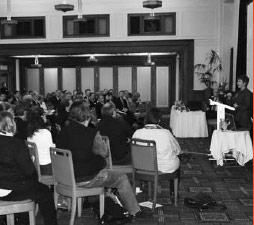Features | Transparency and accountability in e-government | Commonwealth Ombudsman Annual Report 2007-08
 Transparency and accountability in e-government Transparency and accountability in e-government | |
| 30th Anniversary SeminarAugust 2007 | FEATURE |
Mr John Wood of Baljurda Comprehensive Consulting spoke of Maintaining transparency and accountability in e-government. He said the challenge for government is to ensure that those who are not computer literate, or have some form of limiting disability, are not discriminated against. He observed that when government makes use of automated systems in decision-making, reviewers need to question whether that system has ‘the capacity … to consider all the circumstances applicable to a decision-making context’. To ensure this happens, no adverse decision should be finalised without human intervention. Ms Kayelle Wiltshire of the Australian Government Information Management Office (AGIMO) commented that ‘Accountability and transparency in e-government is essential if we are going to gain, and maintain, the trust of citizens when they access services online and conduct transactions with government’. Ms Wiltshire spoke of AGIMO’s strategy for an enhanced online service point, which will enable people to choose their preferred method of contact with government. If people access services this way, they must be confident that their details are secure and their privacy has been maintained. ‘If we ensure accountability and transparency are inbuilt into our systems, they have the potential to improve the accuracy and consistency of decision-making processes.’ | |
 The level of interaction between the general public and government has increased, and the ways in which people deal with government has changed markedly over the years. Technology has helped to improve public administration, allowing people to liaise with government agencies at their convenience. However, technology throws up new challenges.
The level of interaction between the general public and government has increased, and the ways in which people deal with government has changed markedly over the years. Technology has helped to improve public administration, allowing people to liaise with government agencies at their convenience. However, technology throws up new challenges.